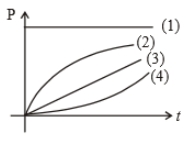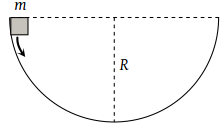A particle is moving on the circular path of the radius (R) with centripetal acceleration . Then the correct relation showing power (P) delivered by net force versus time (t) is

1. 1
2. 2
3. 3
4. 4

1. \(\frac{4}{3}~\text{J}\)
2. \(\frac{5}{6}~\text{J}\)
3. \(\frac{3}{2}~\text{J}\)
4. \(\frac{7}{5}~\text{J}\)
A force F is applied on a body which moves with a velocity v in the direction of the force, then the power will be
1.
2. Fv
3.
4. F/v
A mass m slips along the wall of a semispherical surface of radius R. The velocity at the bottom of the surface is [ MP PMT 1993]

(1)
(2)
(3)
(4)
Three different objects of masses and m3 are allowed to fall from rest and from the same point ‘O’ along three different frictionless paths. The speeds of the three objects, on reaching the ground, will be in the ratio of
(1)
(2)
(3) 1 : 1 : 1
(4)
A sphere of mass m is tied to end of a string of length l and rotated through the other end along a horizontal circular path with speed v. The work done by centripetal force in full horizontal circle is
(1) 0
(2)
(3)
(4)
A ball is suspended by a thread of length l. What minimum horizontal velocity has to be imparted to the ball for it to reach the height of the suspension:
(1) gl
(2) 2 gl
(3)
(4)
Work done by a frictional force is
(1) Negative
(2) Positive
(3) Zero
(4) All of the above
A body moves a distance of 10 m along a straight line under the action of a force of 5 N. If the work done is 25 joules, the angle which the force makes with the direction of motion of the body is
(1) 0°
(2) 30°
(3) 60°
(4) 90°
A mass of 0.5kg moving with a speed of 1.5 m/s on a horizontal smooth surface, collides with a nearly weightless spring of force constant k = 50 N/m. The maximum compression of the spring would be
(1) 0.15 m
(2) 0.12 m
(3) 1.5 m
(4) 0.5 m






